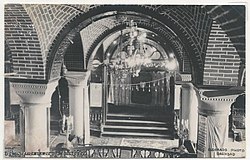Great Synagogue of Baghdad: Difference between revisions
Appearance
Content deleted Content added
| Line 59: | Line 59: | ||
{{coord missing|Iraq}} |
{{coord missing|Iraq}} |
||
[[Category:Edot Hamizrach]] |
|||
[[Category:Jews and Judaism in Baghdad]] |
[[Category:Jews and Judaism in Baghdad]] |
||
[[Category:Orthodox synagogues]] |
[[Category:Orthodox synagogues]] |
||
| Line 66: | Line 67: | ||
[[Category:Sephardi Jewish culture in Asia]] |
[[Category:Sephardi Jewish culture in Asia]] |
||
[[Category:Sephardi synagogues]] |
[[Category:Sephardi synagogues]] |
||
{{Iraq-struct-stub}} |
{{Iraq-struct-stub}} |
||
Revision as of 12:49, 18 September 2021
| Great Synagogue of Baghdad | |
|---|---|
 | |
| Religion | |
| Affiliation | Orthodox Judaism |
| Rite | Edot Hamizrach |
| Status | Museum |
| Location | |
| Location | |
| Architecture | |
| Style | Persian |
The Great Synagogue of Baghdad (Template:Lang-ar), also known as the Shaf ve’Yativ Synagogue, is traditionally believed to stand on the site of a synagogue built by King Jeconiah who was exiled from the Land of Israel to Babylon in 597 BCE. It is said that material gathered from the ruins of the Temple in Jerusalem was used in its construction.[1] The building now serves as a museum in which the synagogue had been rebuilt.
See also
References
- ^ Avishur, Prof. Yitzhak (Summer 2001). "Synagogues in Babylon". Nehardea: Journal of the Babylonian Jewry Heritage Center. Archived from the original on 2007-06-06. Retrieved 2007-05-29.
